biochemical and haematological profile - Universitatea de Ştiinţe ...
biochemical and haematological profile - Universitatea de Ştiinţe ...
biochemical and haematological profile - Universitatea de Ştiinţe ...
Create successful ePaper yourself
Turn your PDF publications into a flip-book with our unique Google optimized e-Paper software.
PATHOLOGICAL EFFECTS AND TISSUE DISTRIBUTION OF<br />
MICROCYSTIN‐LR (MC‐LR) AFTER 48 HOURS NON INVASIVE<br />
EXPOSITION OF NEWLY HATCHED MEDAKA<br />
(ORYZIAS LATIPES) ELEUTHERO‐EMBRYOS<br />
Hélène Huet 1 , Delphine Franko 2 , Chakib Djediat 2 ,<br />
Eva Perez 2 , François Crespeau 1 , Amaury <strong>de</strong> Luze 2<br />
1 Ecole Nationale Vétérinaire d’Alfort (France)<br />
2 Muséum National d’Histoire Naturelle <strong>de</strong> Paris (France)<br />
Abstract<br />
Medaka fishes eulethero‐embryos were submitted at 48 hours period of immersion in MC‐LR<br />
containing media at 1, 5, 10, 15 <strong>and</strong> 20 µg/ml concentration. Significant mortality (>10%) is only<br />
observed for higher MCLR concentration (20µg/ml) in medium.<br />
Microscopic pathological effects after 48 hours immersion in MC‐LR solution were searched on<br />
transverse sections of paraffin embed<strong>de</strong>d embryos fixed in formal<strong>de</strong>hy<strong>de</strong>. Histopathologic<br />
studies of paraffin embed<strong>de</strong>d embryos shows, from 10 µg/ml MC‐LR concentration, with variable<br />
intensity, vacuolization of enterocytes <strong>and</strong> hepatocytes, <strong>de</strong>generative <strong>and</strong> necrotic changes.<br />
On same material, immuno‐labeling with specific monoclonal antibodies against MC‐LR was also<br />
performed <strong>and</strong> appeared constantly <strong>and</strong> strongly positive in intestine (enterocytes <strong>and</strong> lamina<br />
propria), liver (hepatocytes <strong>and</strong> probably macrophagic cells along sinusoids bor<strong>de</strong>r). A faint<br />
labeling was also characterized in kidneys epithelial cells, pancreas <strong>and</strong> yolk vesicle epithelial<br />
bor<strong>de</strong>r. No labeling was observed in skin, gills, oral epithelium, esophagus <strong>and</strong> stomach, heart<br />
<strong>and</strong> vascular system, muscles, nervous central system…<br />
Ultramicroscopic pathological effects after 48 hours immersion in MCLR solution were also<br />
searched on ultrathin sections of embryos fixed in paraformal<strong>de</strong>hy<strong>de</strong> <strong>and</strong> embed<strong>de</strong>d in resin.<br />
From 10 µg/ml MC‐LR concentration, transmission electronic microscopy clearly shows disruption<br />
of intercellular junctions in enterocytes <strong>and</strong> hepatocytes, some cytoplasmic vacuolation of<br />
enterocytes, alteration of hepatocytes membrane with regression of microvillous cell bor<strong>de</strong>r with<br />
reduction of Disse space length <strong>and</strong> abnormal biliary canaliculi bor<strong>de</strong>r.<br />
INTRODUCTION<br />
Microcystins (MCs) are a family of hepatotoxic cyclic heptapepti<strong>de</strong>s comprising at least 80<br />
variants <strong>and</strong> congeners. All toxic microcystin variants contain a unique hydrophobic amino acid<br />
3‐amino‐9‐methoxy‐10‐phenyl‐2,6,8‐trimethyl‐<strong>de</strong>ca‐4(E)‐dienoic acid (ADDA) (kongsuwan et<br />
al., 1988). The prototype compound is MC‐LR, which have Leucine (L) <strong>and</strong> arginine (R) at the<br />
two hypervariable positions in the ring structure (Rinehart et al., 1988; Carmichael, 1992).<br />
These toxins are produced by a wi<strong>de</strong> variety of planktonic cyanobacteria, which are one of the<br />
most primitive <strong>and</strong> worldwi<strong>de</strong> distributed families of photosynthetic organisms (Brock, 1973,<br />
Ueno et al., 1998).<br />
MCs represent potential environmental fresh water toxins, mainly when climatic conditions<br />
promote blooms of cyanobacteria in pools, pond or lakes.<br />
The primary toxic effect of microcystins is inhibitory reversible binding at the catalytic site of<br />
protein phosphatases 1 <strong>and</strong> 2A. This interaction involved principally the ADDA group. The<br />
presence of the methyl‐<strong>de</strong>hydro‐alanine (Mdha) inducted an irreversible inhibition by covalent<br />
linkage to the cystein sulphur on the phosphatases PP1 <strong>and</strong> PP2A (MacKintosh et al., 1995;<br />
Runnegar et al., 1995). Direct injection of MCLR in mammals induced protein phosphatases<br />
36



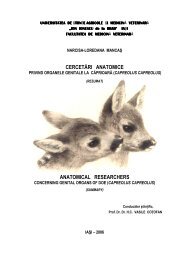
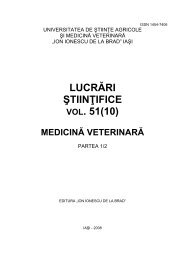

![rezumat teză [RO]](https://img.yumpu.com/19764796/1/190x245/rezumat-teza-ro.jpg?quality=85)
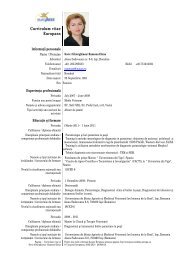



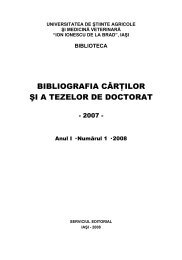
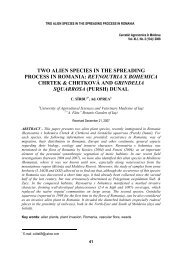
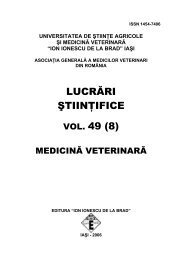
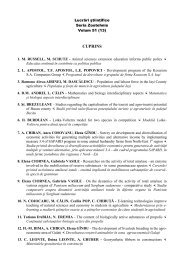

![rezumat teză [RO] - Ion Ionescu de la Brad](https://img.yumpu.com/14613555/1/184x260/rezumat-teza-ro-ion-ionescu-de-la-brad.jpg?quality=85)
